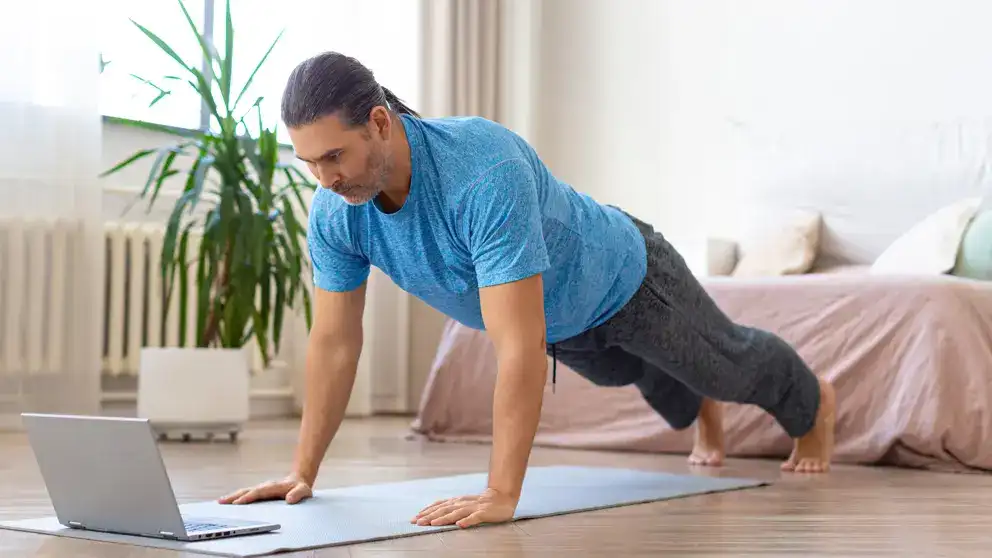Most of us are sitting more these days. And when you’re sitting at your desk or on your couch, the idea of getting some exercise, while good, may seem far away.
But what if you could “snack” on exercise throughout the day and improve your health and fitness?
One of the biggest fitness trends is exercise snacking. It’s the notion of breaking up your day with short bursts of exercise, just like treating yourself to a snack.
Exercise snacking isn’t new, although the research and the term are. If you’ve ever been sitting at your computer or watching TV and had the urge to stand up and walk around or stretch, you’ve had an exercise snack. This type of body and brain break is famous among many writers. Dan Brown, author of The Da Vinci Code, spends a minute every hour when writing doing push-ups and sit-ups. In fact, these short bursts of exercise can give you an energy boost and improve your productivity.
Guidelines beginning to reflect exercise snacking
Thousands upon thousands of research papers tell us that exercise is good for us. Despite that, as little as 20% of adults in Canada get enough activity. Many people say they can’t afford to go to a gym or simply don’t have enough time to exercise.
In recent decades, the minimum recommended exercise for a single session has been decreasing.
The latest guidelines in the US, and new guidelines from the World Health Organization, no longer have a set minimum of activity at a given time. The weekly target is at least 150 minutes of physical activity. But you can choose how to meet that goal. This means as little as one minute of exercise, maybe less, counts towards your weekly target.
The science behind exercise snacking
Exercise snacking has grown out of research on high intensity interval training (HIIT), repeated short bursts of high intensity exercise with intervals of active rest.
Scientists asked whether these intervals could be spread out over the day. Turns out, they can. When three all-out bursts of 20 seconds of cycling were separated by at least one hour of rest, improvements in fitness were similar to those people who did the three bursts with only three minutes rest.
Now this doesn’t mean going to the gym for one minute several times per day — or having your own home gym. Or even getting into spandex. The beauty of exercise snacks is that you don’t need any equipment. Even doing stairs count.
Climbing three flights of stairs, three times a day, three days a week for six weeks resulted in improvements in fitness in non-exercisers. This small amount of activity was enough to improve insulin metabolism in people who were overweight. This confirmed earlier research indicating that two minutes of walking every 20 minutes reduces blood sugar.
How to exercise snack
What makes the exercise snack different from standing up and stretching or walking to the kitchen, is increasing your heart rate.
You should target an activity that gets you breathing faster and makes it hard to sing or whistle (if you’re so inclined). But you don’t need to worry about sweating, as moving for 1-2 minutes isn’t enough time for you to start sweating. This is great because you can do it in your everyday clothes.
Some activities you can try:
- stair climbing
- jogging in place
- jumping jacks and burpees
- a brisk walk or jog around the block
- If you have a stationary bike or rowing machine, just jump on that for a minute or so.
If you want something of longer duration, there’s the Royal Canadian Air Force 11-minute workout plan. Developed in 1959, this program can be done at home without any equipment. A modification of this program was recently studied, indicating its effectiveness at improving fitness.
It’s still ideal to get in your regular meal of exercise — whether that’s a brisk walk, a swim, bike ride or a soccer game — as well as your snacks. But exercise snacks are a great way to build activity into your day and start the process of forming a habit.
If you’re like me and have a hard time remembering to get up every so often, technology is here to help. You could use anything from a simple cooking timer, to the alarm on your phone, to a watch that vibrates. Perhaps the most effective may be using a screen time app on your computer, tablet or phone. Some of these apps lock your device for a set period of time, further motivating you to get up and move.
So feel free to take as many exercise snacks throughout the day as you can, knowing you’re on track to keeping fit and healthy.
- 6 tips to add more physical activity to your day
- Get the facts behind common exercise myths

Dr. Scott Lear
Dr. Scott Lear is a leading researcher in the prevention and management of heart disease. He holds the Pfizer/Heart and Stroke Foundation Chair in Cardiovascular Prevention Research at St. Paul’s Hospital in Vancouver, and he is a professor in the faculty of health sciences and the department of biomedical physiology and kinesiology at Simon Fraser University. Dr. Lear also lives with heart disease himself. Follow his blog at drscottlear.com.

